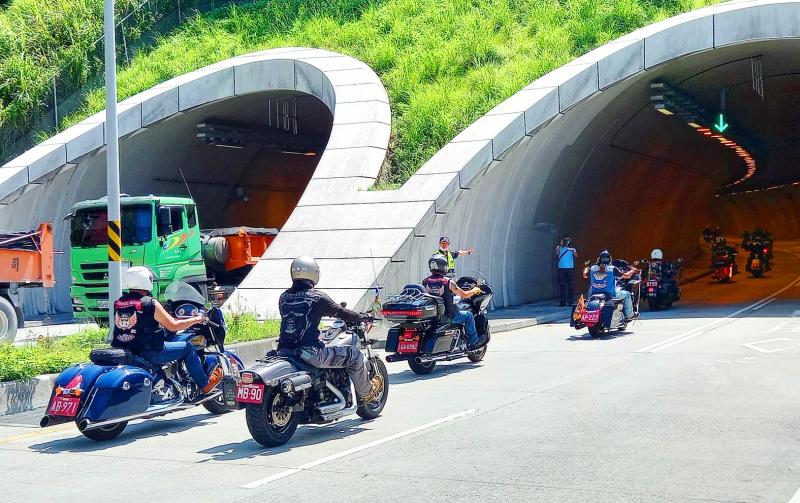Riders of motorcycles with engine displacement of more than 250 cubic centimeters (cc) could from next month be permanently allowed to access improved sections of the Suhua Highway along the east coast following a six-month trial, the Ministry of Transportation and Communications said yesterday.
The trial was launched on Sept. 30 last year by the Directorate-General of Highways, which tasked the Chinese Institute of Transportation to analyze traffic data, Department of Railways and Highways Director Lin Fu-san (林福山) said.
Results of the data analysis showed that the motorcycles would not compromise road safety, Lin said.

Photo: Chiang Chih-hsiung, Taipei Times
The highways agency has included scenarios involving motorcycle accidents in its disaster drills, Lin added.
The highways agency has officially proposed that motorcycles be allowed on improved sections of the Suhua Highway, he said, adding that it has also proposed a trial that would temporarily allow motorcycles with 50cc to 250cc engines to use the same sections.
The trial would be held between Hualien County’s Hejhong (和中) and Heren (和仁), where riders of smaller motorcycles would be allowed to use the shoulders of the highway, Lin said.
The ministry has yet to approve the two proposals, he said.
“Our principle of reviewing the proposals is that safety should be the top priority,” he said. “The Directorate-General of Highways should be able to confirm all the details related to opening the highway’s improved sections to heavy motorcycles next month, and the trial for motorcycles with 50cc to 250cc engines should begin in September.”
The government restricts motorcycle riders from accessing certain road sections to protect their safety, Minister of Transportation and Communications Wang Kwo-tsai (王國材) said.
However, restrictions should be lifted if they force them to use more dangerous roads instead, he said.
The Suhua Highway improvement project, which was completed in 2020, has improved the safety of three sections of the highway that previously were vulnerable to landslides, the ministry said.
In other news, Wang said the Taiwan Railway Labor Union should not threaten to strike on national holidays every time its negotiations with the Taiwan Railways Administration (TRA) fail to reach its expectations.
The railway agency and the union have been negotiating over 12 sets of supporting rules of the State-run Taiwan Railways Corporation Act (國營台灣鐵路股份有限公司設置條例), which the Legislative Yuan passed on May 27 this year. The government seeks to stipulate the supporting rules before the establishment of Taiwan Railway Corp, scheduled for 2024.
However, the union on Wednesday said that its members would strike during the Mid-Autumn Festival in September, on Double Ten National Day in October and on Nov. 26, when local elections are to be held.
The negotiations focused on whether all TRA employees should get a raise and how an employee welfare fund should be established, Wang said.
“I believe any comprehensive raise for employees should be discussed after a corporation has generated profits, otherwise the company would be mired in debt when it begins to operate,” he said. “However, entry-level employees who make less than NT$30,000 per month should be quickly given a raise.”
“I hope that each side can engage in discussions in a calm and rational manner. Negotiations between employers and labor representatives take time, and the union should not keep talking about striking on national holidays whenever things do not go their way,” he said. “Such rhetoric would only unsettle the public.”

Taiwan is to commence mass production of the Tien Kung (天弓, “Sky Bow”) III, IV and V missiles by the second quarter of this year if the legislature approves the government’s NT$1.25 trillion (US$39.78 billion) special defense budget, an official said yesterday. Commenting on condition of anonymity, a defense official with knowledge of the matter said that the advanced systems are expected to provide crucial capabilities against ballistic and cruise missiles for the proposed “T-Dome,” an advanced, multi-layered air defense network. The Tien Kung III is an air defense missile with a maximum interception altitude of 35km. The Tien Kung IV and V

The disruption of 941 flights in and out of Taiwan due to China’s large-scale military exercises was no accident, but rather the result of a “quasi-blockade” used to simulate creating the air and sea routes needed for an amphibious landing, a military expert said. The disruptions occurred on Tuesday and lasted about 10 hours as China conducted live-fire drills in the Taiwan Strait. The Civil Aviation Administration (CAA) said the exercises affected 857 international flights and 84 domestic flights, affecting more than 100,000 travelers. Su Tzu-yun (蘇紫雲), a research fellow at the government-sponsored Institute for National Defense and Security Research, said the air

Taiwan lacks effective and cost-efficient armaments to intercept rockets, making the planned “T-Dome” interception system necessary, two experts said on Tuesday. The concerns were raised after China’s military fired two waves of rockets during live-fire drills around Taiwan on Tuesday, part of two-day exercises code-named “Justice Mission 2025.” The first wave involved 17 rockets launched at 9am from Pingtan in China’s Fujian Province, according to Lieutenant General Hsieh Jih-sheng (謝日升) of the Office of the Deputy Chief of the General Staff for Intelligence at the Ministry of National Defense. Those rockets landed 70 nautical miles (129.6km) northeast of Keelung without flying over Taiwan,

A strong continental cold air mass is to bring pollutants to Taiwan from tomorrow, the Ministry of Environment said today, as it issued an “orange” air quality alert for most of the country. All of Taiwan except for Hualien and Taitung counties is to be under an “orange” air quality alert tomorrow, indicating air quality that is unhealthy for sensitive groups. In China, areas from Shandong to Shanghai have been enveloped in haze since Saturday, the ministry said in a news release. Yesterday, hourly concentrations of PM2.5 in these areas ranged from 65 to 160 micrograms per cubic meter (mg/m³), and pollutants were